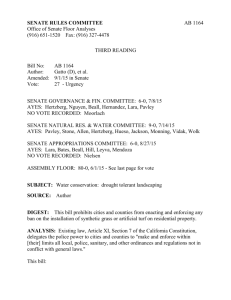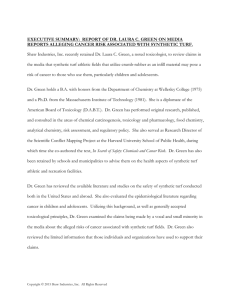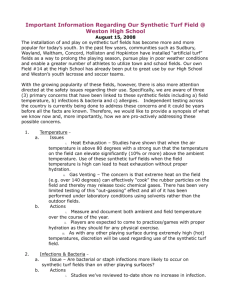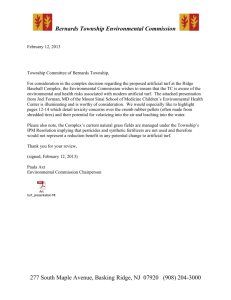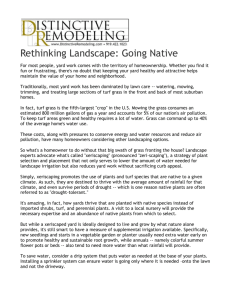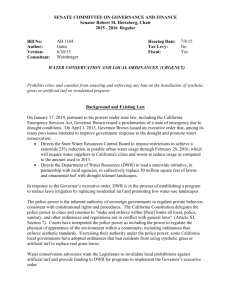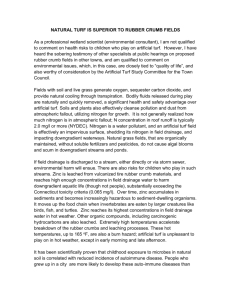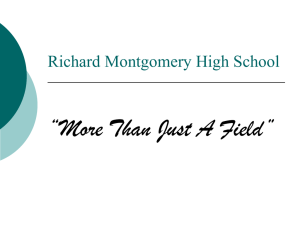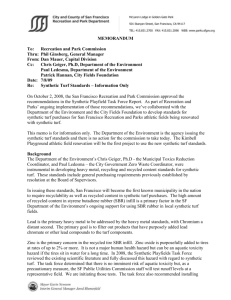Vancouver Sun - Saturday, July 19, 2008
advertisement
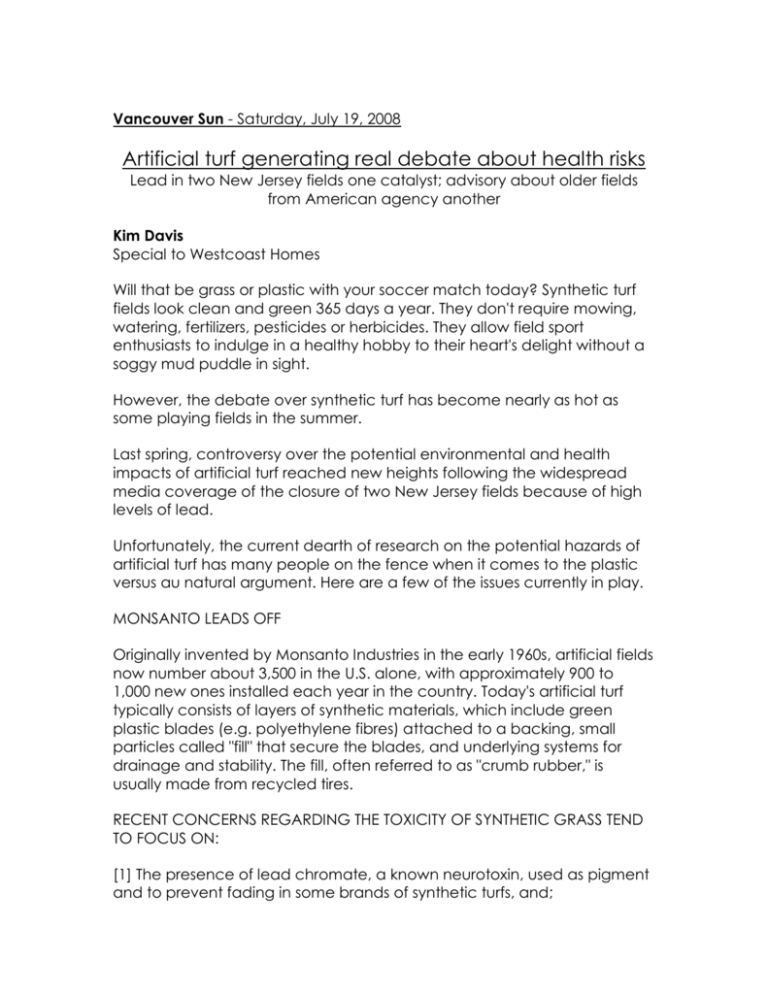
Vancouver Sun - Saturday, July 19, 2008 Artificial turf generating real debate about health risks Lead in two New Jersey fields one catalyst; advisory about older fields from American agency another Kim Davis Special to Westcoast Homes Will that be grass or plastic with your soccer match today? Synthetic turf fields look clean and green 365 days a year. They don't require mowing, watering, fertilizers, pesticides or herbicides. They allow field sport enthusiasts to indulge in a healthy hobby to their heart's delight without a soggy mud puddle in sight. However, the debate over synthetic turf has become nearly as hot as some playing fields in the summer. Last spring, controversy over the potential environmental and health impacts of artificial turf reached new heights following the widespread media coverage of the closure of two New Jersey fields because of high levels of lead. Unfortunately, the current dearth of research on the potential hazards of artificial turf has many people on the fence when it comes to the plastic versus au natural argument. Here are a few of the issues currently in play. MONSANTO LEADS OFF Originally invented by Monsanto Industries in the early 1960s, artificial fields now number about 3,500 in the U.S. alone, with approximately 900 to 1,000 new ones installed each year in the country. Today's artificial turf typically consists of layers of synthetic materials, which include green plastic blades (e.g. polyethylene fibres) attached to a backing, small particles called "fill" that secure the blades, and underlying systems for drainage and stability. The fill, often referred to as "crumb rubber," is usually made from recycled tires. RECENT CONCERNS REGARDING THE TOXICITY OF SYNTHETIC GRASS TEND TO FOCUS ON: [1] The presence of lead chromate, a known neurotoxin, used as pigment and to prevent fading in some brands of synthetic turfs, and; [2] The use of recycled tires, which can contain varies amounts of petrochemicals, heavy metals, polycyclic aromatic hydrocarbons and other volatile organic compounds. In the case of lead chromate, the concern is that the plastic used to make artificial grass can break down over time, and that people using the fields may ingest or inhale the resulting lead-contaminated dust. While the potential risks associated with exposure are still unknown, the U.S. Centers for Disease Control and Prevention issued an advisory note regarding older fields. Eddy Bresnitz, New Jersey's deputy health commissioner, noted in an article in USA Today that though the health risks are likely very low, "to the extent we can take preventive measures, we should do that." Those who use the fields are advised to wash up and launder their clothes after playing on them, and it has also been recommended that the synthetic surfaces be frequently watered to keep dust levels down. When it comes to the rubber fill, the Swedish Chemicals Inspectorate recommends that recycled tires not be used for this application. It notes that high levels of phthalates and phenols, which are not chemically bound to the rubber, can leach and that these chemicals are carcinogenic and bioaccumulative. Unfortunately, the limited amount of research to date has not yet been able to determine how, or to what degree, these chemicals might be absorbed through inhalation, digestion, or dermal contact. BACTERIA A UTILITY PLAYER Another health concern associated with synthetic turf is the threat of bacterial infections. Brad Fresenburg of the University of Missouri notes in an article on Plant Management Network International's website that natural grass has a microbial system that makes it self-cleaning. Lacking this, synthetic fields offer warmth, moisture, and a mix of bodily fluids in which bacteria can thrive. Proper maintenance of synthetic turf requires that the fields be sanitized regularly. According to Synthetic Turf Sports Fields: A Construction and Maintenance Manual, some owners disinfect their fields as twice a month, with more frequent cleanings for sideline areas, where contaminants can concentrate. HOT CORNER ALWAYS HOTTER When it comes to the environment, synthetic greens certainly heat things up. Last summer, as part of a study on heat radiation, Stuart Gaffin, an atmospheric scientist in New York City, found that synthetic-turf fields can be up to 60 degrees F (16 C) hotter than grass, with surface temperatures reaching as high as 160 F (71 C) on summer days. For example, Griffin recorded the atmospheric temperature as 78 F (26 C) one early afternoon; the temperature on a grass field receiving direct sunlight was 85 F (29 C), while an adjacent synthetic turf field had heated up to 140 F (60 C). This becomes not only a hazard for users, but also contributes to the urban heat island, which happens when cities become hotter than surrounding areas due to heat absorbed by dark surfaces such as roofs and asphalt. Although one of the advantages of synthetic turf is that it does not require irrigation, some installations must be watered in an effort to control excessive heat. LIFETIME CAREER Advocates for synthetic turf often point to the fact that such systems do not require the use of carbon-spewing maintenance equipment, such as mowers. This means that not only are maintenance costs reduced, but that there are fewer greenhouse gases contributing to climate change. While true, this is unfortunately not quite a complete picture of either grass or synthetic turf. The Athena Institute, an Ontario-based non-profit, says that in order to offset the estimated 56 tons of carbon created in the production, installation, maintenance and disposal of one 9,000-square-metre synthetic field -- an average-sized soccer field -- and compensate for the loss of the carbon-absorbing properties of the grass it replaced, one would have to plant approximately 1,861 trees, which would need to grow for at least 10 years. MORE TEAM STATS For a more detailed review of the benefits and challenges of both synthetic turf and grass fields, check out the March 2008 issue of Environmental Health Perspectives at ehponline.org on the Internet. Kim Davis is a Vancouver sustainable-design consultant. E-mail: redkimwrites@gmail.com WHAT'S IN THE NAME ASTROTURF? Now little used, the Houston Astrodome was the world's first domed stadium -- and, in that capacity, a major contributor to the development of artificial turf. When it opened in 1965, the playing field had been planted with real grass and panes of Lucite had been installed in the dome to admit sunlight. Baseball players, however, reported that the glare from the panes in the dome made the tracking of a fly ball a challenge. Stadium management painted over the panes to eliminate the glare, a decision that, of course, starved the grass of sunlight and eventually killed all the grass. Management, for the 1966 season, installed ''AstroTurf,'' firstly and for the home opener on the infield and later in the season on the outfield. The last Major League Baseball game was played in the historic structure at the end of the 1999 season, three years after Astros right fielder Derek Bell (left) was hit by a ball while at bat. -- ''Reliant Astrodome,'' Wikipedi © The Vancouver Sun 2008
